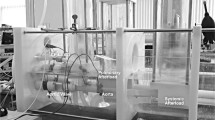Summary
An electrohydraulically driven left ventricular assist device (LVAD) has been developed in our laboratory. Over years of in vitro and in vivo testing, a “suction” problem has been pointed out as one of the major problems related to the device mechanism. The suction problem involves collapse of the left atrium, which can be caused by excessive negative pressure generated by the active blood-filling mechanism, and can lead to damage to the atrium or an air-embolism. We have developed methods for properly controlling the assistance output, depending upon the inlet pressure conditions. Algorithms have been developed for setting an absolute limit to negative pressure and for the regulation of the diastolic velocity of the device. The regulating system is based on the estimation of left atrial pressure (LAP), using the internal pressure of the polymer bellows and the motor current as raw information indicating the status of the left atrium. The estimation is based upon direct analysis of the signal wave form, coupled with the use of fuzzy logic in determining significant parameters such as the systolic peak, diastolic peak, and diastolic integral. Results of experiments using a mock-circulation system have shown that the new control system performs satisfactorily in detecting suction. An animal experiment was conducted to verify the feasibility of the methods. In a 17-day experiment using an adult sheep with a left ventricular assist device, there was no sign of damage or suction-related problems when we used the new method for controlling the diastolic velocity depending upon the bellows water pressure. In this paper, the methods are described and the results are documented.
Access this chapter
Tax calculation will be finalised at checkout
Purchases are for personal use only
Preview
Unable to display preview. Download preview PDF.
Similar content being viewed by others
References
Choi J-U (1992) A study on the development of an electrohydraulic left ventricular assist device. Ph D dissertation, Seoul National University, Seoul, pp 18–19
Lee S-W (1995) Pump output regulation algorithm for an electrohydraulic left ventricular assist device using pressure waveform analysis. ME dissertation, Seoul National University, Seoul, pp 10–11
Stöcklmayer C, Dorffner G, Schmidt C, Schima H (1995) An artificial neural network-based noninvasive detector for suction and left atrium pressure in the control of rotary blood pumps: an in vitro study. Artif Organs 19:719–724
Choi J-S, Ahn Y-H, Lee S-W, Jung C-I, Min B-G (1995) An improvement of velocity control method for prevention of left atrium collapse in left ventricular assist device. Proceedings of KOSOMBE (Korea Society of Medical and Biological Engineering) Spring conference 1995, 71(l):251–255
Choi W-W, Kim H-C, Min B-G (1996) A new automatic cardiac output control algorithm for moving actuator total artificial heart by motor current waveform analysis. Int J Artif Organs 19:189–193
Trinkl J, Havlik P, Mesana T, Mitsui N, Morita S, Demunck JL, Tourres JL, Monties JR (1993) Control of a rotary pulsatile cardiac assist pump driven by an electric motor without a pressure sensor to avoid collapse of the pump inlet. ASAIO J 39:M237–M241
Yoshizawa M, Takeda H, Yambe T, Nitta S (1994) Assessing cardiovascular dynamics during ventricular assistance. IEEE J Eng Med Biology Nov/Dec:687–692
Choi J-S, Choi W-W, Jo Y-H, Park S-K, Min B-G (1995) Development of a stroke output control algorithm using a fuzzy logic for a left ventricular assist device. Proceedings of the 10th Korea Automatic Control conference internation program, Oct 23–25, 1995, pp 514–517
Choi J-S, Choi W-W, Jo Y-H, Park S-K, Min B-G (1995) Development of an algorithm for regulation of inlet blood flow in electrohydraulic left ventricular assist device using fuzzy logic. Proceedings of KFIS (Korea Fuzzy Logic and Intelligent Systems Society) Fall Conference 1995 5(2):387–392
Jae-Soon C, Chanil C, Won-Woo C, Seong-Keun P, Yung-Ho J, Kyoung-Sik O, Jong-** L, Yong-Soon W, Hee-Chan K, Won-Gon K, Byoung-Goo M (1996) Evaluation of electrohydraulic left ventricular assist device through animal experiment. Proceedings of KOSOMBE (Korea Society of Medical and Biological Engineering) Spring conference 1996 18(l):84–87
Author information
Authors and Affiliations
Editor information
Editors and Affiliations
Rights and permissions
Copyright information
© 1998 Springer-Verlag Tokyo
About this paper
Cite this paper
Choi, JS. et al. (1998). Automatic Regulation of Output of an Electrohydraulic Left Ventricular Assist Device Using the Polymer Bellows Water Pressure and Motor Current. In: Akutsu, T., Koyanagi, H. (eds) Heart Replacement. Springer, Tokyo. https://doi.org/10.1007/978-4-431-65921-1_72
Download citation
DOI: https://doi.org/10.1007/978-4-431-65921-1_72
Publisher Name: Springer, Tokyo
Print ISBN: 978-4-431-65923-5
Online ISBN: 978-4-431-65921-1
eBook Packages: Springer Book Archive




